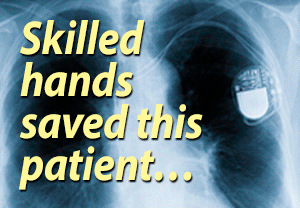 High Blood Pressure? read about PM Programmable Hypertension Control (PHC) therapy
High Blood Pressure? read about PM Programmable Hypertension Control (PHC) therapy
- by Andreska
- 2018-05-26 06:10:49
- Checkups & Settings
- 1438 views
- 5 comments
Hello all!
My first day in the Club. Looking for information about Blood Pressure controlled by PM, found this study, from Dec 2017.
http://jaha.ahajournals.org/content/6/12/e006974
Many patients requiring a pacemaker have persistent hypertension with systolic blood pressures above recommended levels. We evaluated a pacemaker‐based Programmable Hypertension Control (PHC) therapy a sequence of variably timed shorter and longer atrioventricular intervals.
... and apparently works.
I'm going to discuss this with my medic in June, see if some settings can be applied so I can reduce or leave pills. Keep you posted, share your thoughts.
5 Comments
Hypertension control
by Selwyn - 2018-05-26 14:48:48
BP= CO X PR
CO= HR X SV
where BP is blood pressure, CO is cardiac output, PR is peripheral resistance, HR is heart rate, SV is stroke volume . X is multiply.
Therefore, BP= HR x SV x PR
ie. If you control heart rate, and every other criteria is constant, your blood pressure varies. The other thing is that the SV is less as there is less time for ventricular filling. The study got round the body's natural adaption of the HR and SV changes by alternating the AV interval- very clever!
How this pacing regime fits into rate adaptation is anyone's guess.
For some people with persistant hypertension this could be a new, non-pharmacological approach.
Welcome to the club and what an arrival with such a gem of information- well done!
Selwyn
tHIS IS A NON-TRIVIAL ...
by donr - 2018-05-27 03:56:38
...problem to solve & I've had some interesting discussions w/ my cardio about it.
Consider the following description of the circulatory system: The heart is what is called a "Positive displacement pump." (That means that when it pumps, a slug of blood is physically pushed out. If it cannot be pushed out, the pump "stalls," & that spells disaster for the pump.) It functions in a closed loop system. Blood, like all liquids, is non-compressible. The "Piping" of this closed loop system is elastic with the high pressure side (Arteries) having small muscles on their surfaces (At least that's the way my MD daughter describes them). The low pressure side (Veins) have no muscles, but do have a series of valves to prevent back flow. Blood flows prewtty darned fast - takes only about 7-9 deconds to get from the lower arm to wherever the organ that senses taste is located.
Every closed loop system w/ a positive displacement pump in it must have an elastic section of pipe or a compressible gas (like air) to allow the pump to move fluid.
Consider the home that has a well w/ a pump to supply water. There is a tank w/ an air cavity in it that is what controls the pressure in your system to move water when the pump is off. Our heart never stops beating, so it can control the pressure. But how do the other components act and influence BP? Like the elastic piping system carrying the blood. Destroy or vary the elasticity of the vessels - especially the arteries - & the entire BP conttrol problem becomes totally different. Affect the EF & likewise the control problem changes. Ditto for changing the HR and the blood volume.
In short, whoever wrote the algorithm for this function of a PM has ro be a real genius. I named 5 variables above that affect BP and the program can only control two of them - the HR & the Qty of blood in the ventricles when the heart pumps. Very interesting problem!
Donr
You cannot...
by donr - 2018-05-29 10:14:06
...run out & buy one of these - yet.
Selwyn, pls critique thesse comments for accuracy & reasonable analysis.
This is a first step toward something practical that is a long way off. I are an Elkecktrukul Injunier & out of my field, except for the fact that we all perform studies & develop ideas in a parallel manner using long existing principles & methods.
1) There is only one disturbng thing about the study - the principals in the study refuse to share their data so that other researchers can replicate the study to validate it.
2) This was a true first step to see if BP can be controlled in this manner. there was no feedback real time BP sensing system built into the overall system. All BP measurements were conducted external to the body periodically & adjustments made by the study principals. Solving this part of the problem is going to be a real challenge
3) They used a Finapres system BP measurerment device that attaches to a finger and a tonometer that measures BP at the wrist. The feedback to the PM was by human intervention & insertion/modification of parameters.
4) What we see when we have our BP measured is an average of the pressure over MANY beats. The Finapres device apparently can get a handle on BP BEAT for BEAT. Pretty nifty! (Accrding to the website for the Finapres, Mayo Clinic & Johns Hopkins uses this method for BP monitoring. Anyone been there & experienced it?)
5) One question that must be answered to build a practical device is what is the optimal number of beats to be used to determine BP for modulating the BP at the PM level.
6) The math used to model the BP that I read in another website is daunting (Now, but not 50 plus yrs ago when I was a grad student) and will have to keep pace w/ the experimental side of the house.
7) Final note: the real problem for a practical, marketable device is development of the INTERNAL BP sensor to give the PM feedback so it can CONTROL the BP. This report only shows that the BP can be changed by the PM using the method of variation of AV intervals. Every control system needs a feedback loop to tell it how it is doing. Further, the system must be STABLE - not run wild, creating BP control that makes situations worse for the paient (Host). Possible, but difficult, and more than a few yrs away.
Donr
I would pay for this technology... wouldn't you?
by Andreska - 2018-06-14 14:11:16
Thank you all for your comments and ideas. Indeed an interesting discussion.
I've printed the article and went to the hospital where my PM medic works. I meet him and presented him with the basics... no surprise, he already knows about this. In addition, two of the researchers live here in Budapest, teaching in Semmelweis University. My doctor studied the info for a week, and last Friday we met to for my half year check, where we had option to comment this while my settings were checked.
In short, the algorithm is not yet commercial, and is not shared, is a private research and will go with copyrights. Meditronic is not behind this research, and the programming (the algorithm is not just a matter of settings a medic could set up) very probably will go embedded, as an optional "program". I though we are talking about a dishwasher at that point...
Then, eventually this alternative of electro-therapy to reduce/control high blood pressure, that potentially could be a substitute of medication (with no chemical side effects) could emerge as a commodity in a lapse of 10 years, if farmaceutical firms will agree to leave a juicy slide of the market and be replaced by a smart device, on behalf of the better quality of life of PM users with high blood pressure, today consumers of beta blockers and all sort of coctails they sell.
So, for the moment this great idea is not available as a solution for some in this club including me, and (as many disruptive ideas) I think could fall into the category of great technological developments (like electric cars), that we all know that are good, but for commercial reasons fueling the market are undermined by other interests.
In my case, as an "alternative", I was suggested to leave the beta blocker group of medicines, and try another "flavour", to see if my blood pressure goes stable without side effects. I wonder what side effects will pop up now.
My PM has enough battery for some 8 years more, so I pray that when the moment comes and its time to change it for a new device, this technology will be available.
I would gladly purchase this device + algorithm , and leave drugs and side effects.
Wouldn't you?
You know you're wired when...
Your device acts like a police scanner.
Member Quotes
I am an avid scuba diver.

.png)



Fascinating !
by IAN MC - 2018-05-26 09:15:47
Thanks for bringing this to our attention Andreska.
It is early days and far more studies need to be done. I guess the only way you could get involved would be to be part of a clinical trial.
Here in the UK it seems that the main qualification to be put on BP tablets is to be alive ! If I went to my GP just to ask the time, he would measure my BP. If anything comes of the above studies, then sell your pharmaceutical company shares !
Cheers
Ian